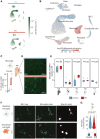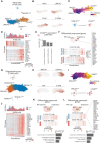Single-cell sequencing of human midbrain reveals glial activation and a Parkinson-specific neuronal state
- PMID: 34919646
- PMCID: PMC9050543
- DOI: 10.1093/brain/awab446
Single-cell sequencing of human midbrain reveals glial activation and a Parkinson-specific neuronal state
Abstract
Idiopathic Parkinson's disease is characterized by a progressive loss of dopaminergic neurons, but the exact disease aetiology remains largely unknown. To date, Parkinson's disease research has mainly focused on nigral dopaminergic neurons, although recent studies suggest disease-related changes also in non-neuronal cells and in midbrain regions beyond the substantia nigra. While there is some evidence for glial involvement in Parkinson's disease, the molecular mechanisms remain poorly understood. The aim of this study was to characterize the contribution of all cell types of the midbrain to Parkinson's disease pathology by single-nuclei RNA sequencing and to assess the cell type-specific risk for Parkinson's disease using the latest genome-wide association study. We profiled >41 000 single-nuclei transcriptomes of post-mortem midbrain from six idiopathic Parkinson's disease patients and five age-/sex-matched controls. To validate our findings in a spatial context, we utilized immunolabelling of the same tissues. Moreover, we analysed Parkinson's disease-associated risk enrichment in genes with cell type-specific expression patterns. We discovered a neuronal cell cluster characterized by CADPS2 overexpression and low TH levels, which was exclusively present in idiopathic Parkinson's disease midbrains. Validation analyses in laser-microdissected neurons suggest that this cluster represents dysfunctional dopaminergic neurons. With regard to glial cells, we observed an increase in nigral microglia in Parkinson's disease patients. Moreover, nigral idiopathic Parkinson's disease microglia were more amoeboid, indicating an activated state. We also discovered a reduction in idiopathic Parkinson's disease oligodendrocyte numbers with the remaining cells being characterized by a stress-induced upregulation of S100B. Parkinson's disease risk variants were associated with glia- and neuron-specific gene expression patterns in idiopathic Parkinson's disease cases. Furthermore, astrocytes and microglia presented idiopathic Parkinson's disease-specific cell proliferation and dysregulation of genes related to unfolded protein response and cytokine signalling. While reactive patient astrocytes showed CD44 overexpression, idiopathic Parkinson's disease microglia revealed a pro-inflammatory trajectory characterized by elevated levels of IL1B, GPNMB and HSP90AA1. Taken together, we generated the first single-nuclei RNA sequencing dataset from the idiopathic Parkinson's disease midbrain, which highlights a disease-specific neuronal cell cluster as well as 'pan-glial' activation as a central mechanism in the pathology of the movement disorder. This finding warrants further research into inflammatory signalling and immunomodulatory treatments in Parkinson's disease.
Keywords: Parkinson’s disease; microglia; midbrain substantia nigra; neuroinflammation; single-cell sequencing.
© The Author(s) 2022. Published by Oxford University Press on behalf of the Guarantors of Brain.
Figures





Comment in
-
Sorting out Parkinson's disease: one cell at a time.Brain. 2022 Apr 29;145(3):811-813. doi: 10.1093/brain/awac071. Brain. 2022. PMID: 35301526 No abstract available.
References
-
- Grünewald A, Kumar KR, Sue CM. New insights into the complex role of mitochondria in Parkinson’s disease. Prog Neurobiol. 2019;177:73–93. - PubMed
-
- Ouchi Y, Yagi S, Yokokura M, Sakamoto M. Neuroinflammation in the living brain of Parkinson’s disease. Parkinsonism Relat Disord. 2009;15(Suppl 3):S200–S204. - PubMed
Publication types
MeSH terms
Substances
Grants and funding
LinkOut - more resources
Full Text Sources
Other Literature Sources
Medical
Molecular Biology Databases
Miscellaneous

